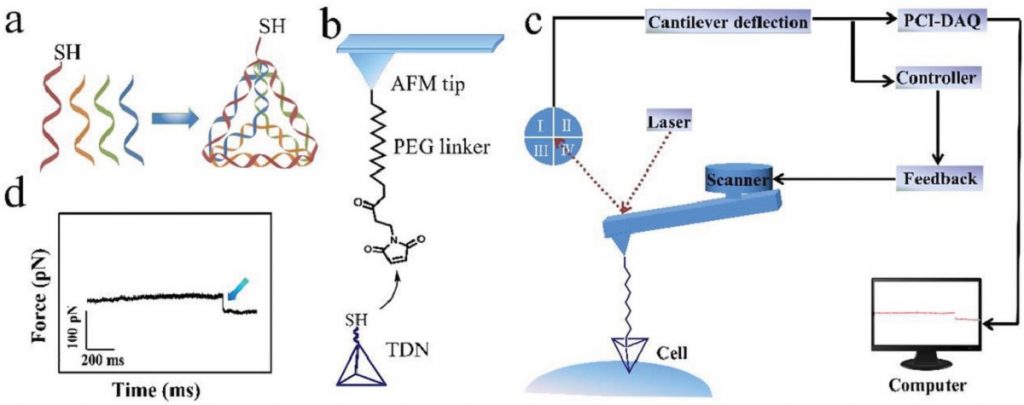Targeted drug delivery and precision medicine have now become a new paradigm in cancer therapy, with nanocarriers, pharmacologically active drugs could be directly delivered into target cancer cells to manage or reverse the course of disease. Nevertheless, the recent critical issue for drug delivery systems is lack of efficient drug delivery carriers.*
DNA nanostructures have attracted considerable attention as drug delivery carriers. However, the transmembrane kinetics of DNA nanostructures remains less explored.*
In the article “Size‐Independent Transmembrane Transporting of Single Tetrahedral DNA Nanostructures” Xi Chen, Falin Tian, Min Li, Haijiao Xu, Mingjun Cai, Qian Li, Xiaolei Zuo, Hongda Wang, Xinghua Shi, Chunhai Fan, Huricha Baigude and Yuping Shan describe how they monitored the dynamic process of transporting single tetrahedral DNA nanostructures (TDNs) monitored in real time using a force-tracing technique based on atomic force microscopy.*
The authors used special NANOSENSORS™ PointProbe® Plus PPP-BSI AFM probes for the single-molecule force tracing.
The NANOSENSORS PPP-BSI AFM tips were modified in two steps as described in their article: First they were washed by Piranha solution (V(H2SO4):V(H2O2) = 3:1) for 1 h, cleaned with ultrapure water twice and absolute ethylacohol once then the AFM tips were dried by argon gas, and cleaned under O3 for 30 min to remove other impurities. After cleaning, the AFM tips were modified with 3-aminopropyltriethoxysilane[17] to generate amino group, it was convenient for linking the heterobifunctional PEG (MAL-PEG2000-SCM, FW≈2000, SensoPathechnologies, Bozeman, MT 1 mg mL−1). After drying with argon, the tips were immersed in a mixture of 100 × 10−9m TDNs, 50 μL NH2OH-reagent (500 × 10−3m NH2OH•HCl, 25 × 10−3m EDTA, pH 7.5), and 50 μL buffer A (100 × 10−3m NaCl, 50 × 10−3m NaH2PO4, 1 × 10−3m EDTA, pH 7.5). After functionalization for 1 h, the AFM tips were washed with PBS for three times and stored at 4 °C .*

Figure 1 from “Size‐Independent Transmembrane Transporting of Single Tetrahedral DNA Nanostructures” by Xi Chen et al:
Schematic diagram of the force tracing test. a) Scheme of assembling the TDNs, from left to right, ssDNA are strands A, B, C, and D (red, orange, green, and blue), respectively. The strand A stretch out a 5‐base ssDNA strand with sulfydryl group. The strand C is labeled with cyanine‐3 (Cy3) fluorophores (Cy3‐TDNs). b) The diagram of connecting TDNs to the AFM tip, the TDNs is attached on the AFM tip with heterobifunctional PEG linker. c) The working principle of constant position mode force tracing technique. d) A typical force tracing curve with force signal (blue arrow).
*Xi Chen, Falin Tian, Min Li, Haijiao Xu, Mingjun Cai, Qian Li, Xiaolei Zuo, Hongda Wang, Xinghua Shi, Chunhai Fan, Huricha Baigude, Yuping Shan
Size‐Independent Transmembrane Transporting of Single Tetrahedral DNA Nanostructures
Global Challenges 2019, 1900075
DOI: https://doi.org/10.1002/gch2.201900075
Please follow this external link to read the full article: https://onlinelibrary.wiley.com/doi/full/10.1002/gch2.201900075
Open Access: The article “Size‐Independent Transmembrane Transporting of Single Tetrahedral DNA Nanostructures” by Xi Chen, Falin Tian, Min Li, Haijiao Xu, Mingjun Cai, Qian Li, Xiaolei Zuo, Hongda Wang, Xinghua Shi, Chunhai Fan, Huricha Baigude and Yuping Shan is licensed under a Creative Commons Attribution 4.0 International License, which permits use, sharing, adaptation, distribution and reproduction in any medium or format, as long as you give appropriate credit to the original author(s) and the source, provide a link to the Creative Commons license, and indicate if changes were made. The images or other third party material in this article are included in the article’s Creative Commons license, unless indicated otherwise in a credit line to the material. If material is not included in the article’s Creative Commons license and your intended use is not permitted by statutory regulation or exceeds the permitted use, you will need to obtain permission directly from the copyright holder. To view a copy of this license, visit http://creativecommons.org/licenses/by/4.0/.